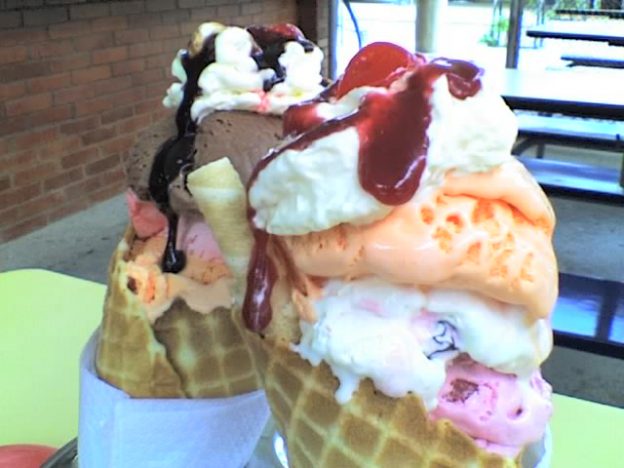Sitting in a master-class on ecology from Jennifer Martiny at UCI someone asked if you could explain ecological diversity in terms of ice cream. Of course you can.
Think about your favorite ice cream store (there are lots to choose from!). Each store has lots of flavors of ice cream.
If you go into a store, say in Irvine, CA (sorry, Jennifer, we snuck out of your workshop to study ice cream!), you can count the number of different flavors of ice cream in the store. This is the richness.
This is a photo of the ice cream lists at my favorite ice cream store (Olive Cafe and Creamery in Mission Beach)
Based on this list, their richness is 7. (Everyone knows that red mint chip is the best, that’s why it is at the top).
Here’s a photo from another store: This store has 12 flavors of ice cream, so their richness is 12.
While this store has a richness of 20.
Note also that the actual richness (STrue) maybe different from the observed richness because these photos may not show the whole display case and all the flavors they have in the back room that they just keep for themselves. We have a sample of the richness of these two ice cream stores.
You can also look at the different flavors of ice cream, and see how popular they are by counting the number of buckets of each ice cream. There are probably lots of buckets of vanilla, a few buckets of strawberry or chocolate, but only one bucket of mango, passion fruit, and pluot. The measure of the number of buckets can be used to calculate the evenness of the ice cream in this store.
That is your alpha diversity.
You can go to another store, say in San Diego, and you can do the same experiment. How many flavors do they have (richness), and do they have the same number of buckets of flavors, or do they have more of some flavors than others (evenness). Again, you’ve measured alpha diversity.
Now, lets travel all over the US visiting ice cream stores and measuring their alpha diversity. Lets say you went to Irvine, San Diego, New York, Boston, Miami, St. Petersburg, you could measure alpha diversity at each store.
But we can do better, and ask how does the alpha diversity compare between stores? Suppose, for example, that you find that San Diego and Irvine have similar taste in ice cream (we love Mexican flavors like Avocado, Elote, Jamaica) while the stores on the East Coast are more similar to each other. Also Miami and St. Petersburg are more similar to each other than either is to Boston or New York.
You have just measured beta diversity.
You have also found that beta diversity decreases with distance, because stores near each other are more similar than stores further apart.
Finally, you think that you have collected enough data that you can finally figure out how many flavors the company really makes. By comparing alpha and beta diversity, you can calculate the total number of flavors.
This is your gamma diversity.
Now we really understand ice cream, lets go eat it!




